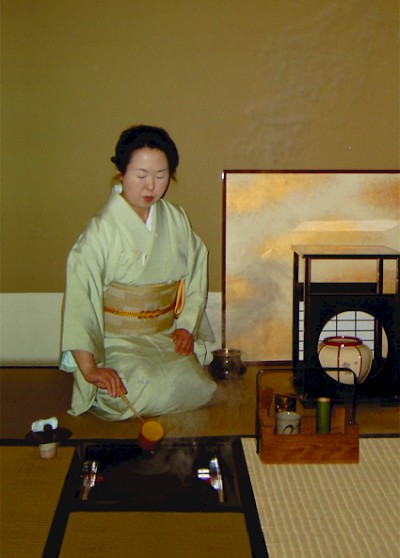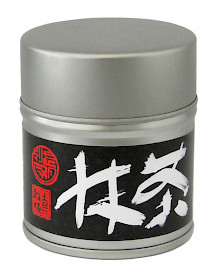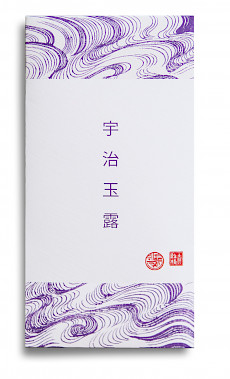MARIMO tea - Manufacture, Import & Wholesale
KYOTO PREFECTURE, HONSHU: ORGANIC MATCHA AND GYOKURO TEA GARDEN IN UJI
The organic matcha and gyokuro tea garden is located in the region of Uji on Honshu, one of the four main islands of Japan, near the city Kyoto in the prefecture with the same name.
"While drinking the organic Uji Matcha and Gyokuro, the taste lets you think of the original taste of the old sorts of matcha and gyokuro, which the noblemen in Kyoto drank hundreds of years ago, when Kyoto was Japan's capital and only the tea cultivated in Uji counted as the one and only tea (Hon-Cha)."
THE STORY OF ORGANIC MATCHA AND ORGANIC GYOKURO FROM UJI
The Ookawa® family has been processing tea leaves to make matcha for the tea ceremony since the end of the Edo period.
The family tea garden is located in the mountainous region of Uji near the ancient capital Kyoto and is one of Japan's traditional tea-growing areas for gyokuro and matcha. The tea garden therefore specialises in the production of gyokuro, and since 1988 also in the production of tencha, which is used for the milling of ceremonial grade matcha. This tencha is gently ground on a granite mill, resulting in a particularly balanced and fine matcha powder. Now, already the sixth generation of the family is running the business and carrying on the tradition of tea cultivation. The tea fields are mainly cultivated with the tea bush varieties Goko and Samidori, which are typical for gyokuro and matcha from Uji.
Tea has been produced in the region around the city of Uji since the 12th century. Uji Matcha is particularly famous. No other area in Japan produces more matcha. This is also due to the close proximity to Kyoto, where there is traditionally a high demand for high-quality matcha consumed during tea ceremonies and in the many temples and tea houses in the city. However, Uji owes its reputation not only to the ancient capital, but also to its mineral-rich soil and nearly frost-free climate, which offer optimal conditions for tea cultivation. Today, Uji Matcha has become a symbol of the Kyoto region and is firmly linked to its culture.
ORGANIC UJI MATCHA AND ORGANIC UJI GYOKURO - SORTS OF TEA:
CULTIVATION AND PROCESSING
Since the tea gardener of the organic Uji matcha and gyokuro tea garden decided to not expose his tea bushes to totally natural conditions, but to make use of a reduced organic manuring – especially with rape pomace – his teas get a well-balanced flavour with a slight sweetness. Just a few tea gardens are able to reach clear and sweet nuances in their teas, without using any fertilizers. But in the case of shaded teas like matcha and gyokuro it is rather difficult without applying, fertilizers. Therefore, organic manuring seems like the best option. Other tea gardens, believing they would focus on a "traditional" production, manure their tea bushes with a lot of mineral fertilizers, which gives the tea an often extreme sweetness. The use of significant portions of chemical and synthetic pesticides, used to get rid of pest infestations in the gardens, should cause goose bumps for reflective tea drinkers.
The tea gardeners questions if the above mentioned “traditional” production of many non-organic gyokuro and matcha tea gardens is really a traditional production method, because in the zenith of shaded tea production times, when aristocrats had fallen in love with shaded teas, such manuring was unthinkable. Every single tea drinker needs to decide for himself whether one preferes the immoderately sweet flavour of a matcha or gyokuro, which is produced with the help of the chemical industry, or if one favours the taste of this pure gyokuro and matcha.
The most important thing for matcha is – and this is where all three fractions share the same opinion – that it is ground by a stone mill right after the leaf veins are taken out. In contrast to simple powder tea, which is ground in a ceramic mill in far bigger amounts, stone mills can produce only about 30g per hour of the fine powder tea. This is the second reason, besides the shading of the tea bushes, why a good matcha is quite expensive.
FLAVOUR
It is very important to the tea farmer of the organic tea garden in Uji, that his teas are really traditionally produced, which means not to use any of the chemical and synthetic pesticides, fertilizers or colorants. This philosophy helps him to make both sorts of strongly shaded tea, matcha and gyokuro, well-balanced in their flavour and without any artificially sweet taste. With experiencing the flavour of the organic Uji Matcha it is possible to get a hint of how the original sorts of Matcha tasted like, in times when Kyoto was still Japan's capital city and only the tea coming from Uji counted as the one and only tea (Honcha).
The use of a stone mill can be perceived very clearly with the tongue, since the tiny particles of the matcha powder are not just finer, and induce a far more comfortable feeling on the tongue, but the tea also tastes much softer as common powder tea. Nevertheless the removing of the leaf veins before the grounding with a stone mill plays an important role as well because it improves the flavour and the feeling on the tounge immensely.
HISTORY
Not far away from Kyoto, where from 794 to 1869 the imperial court of Japan resided, is a small town called Uji. It became well-known when the aristocrats started a new kind of game, where the person, who could tell which of the teas was the "original" (Hon-Cha) and which was the "not original" tea (Hi-Cha), gained the victory. Regarded as "original" were only Togano-teas, and a little bit later it was the ones coming from Uji. Since this time is Uji one of the reputable places for tea cultivation.
The drinking of powder tea, which became a common form of tea preparation in China during the Song Dynasty (960-1279), developed to an art in the Japanese tea ceremony (Chado), having its zenith in Japan, while it was almost forgotten in China. Because of the mildness of shaded teas, favoured by the aristocrats, Uji became one of the most important places for the production of matcha and gyokuro, for whom the tea bushes are shaded about three weeks before the harvest.



